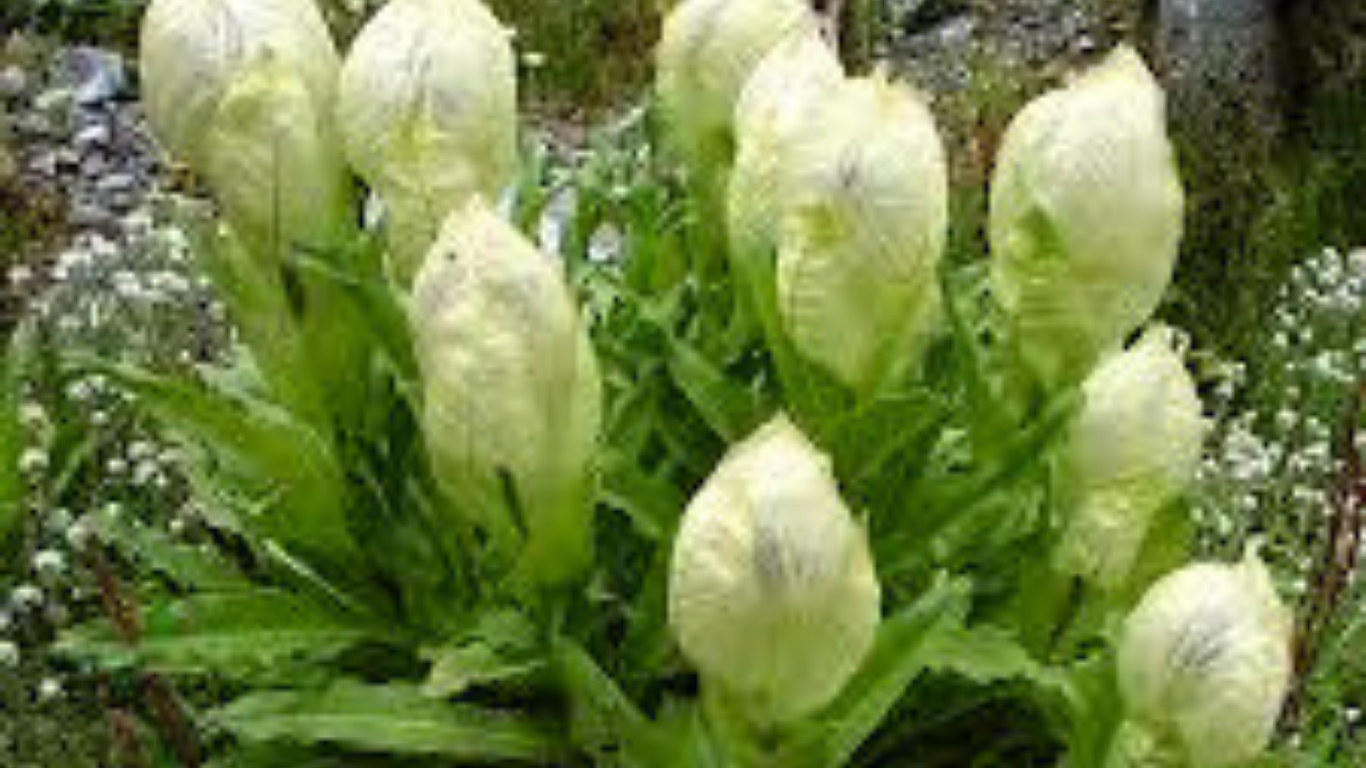The Brahma Kamal, Uttarakhand’s state flower, is a rare and beautiful bloom that holds a special place in the heart of the Himalayas. Known scientifically as Saussurea obvallata, this flower grows in the high altitudes of the Garhwal and Kumaon regions, often above 3,000 meters. Its star-shaped, pale yellow petals and delicate fragrance make it a symbol of purity and resilience, thriving in the harsh, cold slopes of Uttarakhand’s mountains. Revered in Hindu mythology as a sacred offering, it’s linked to gods like Brahma and Shiva. Found in places like the Valley of Flowers, it blooms briefly in July and August, drawing trekkers and devotees. This article explores the Brahma Kamal’s beauty, cultural significance, ecological role, and conservation challenges. Its rarity and spiritual value make it a proud emblem of Uttarakhand, reflecting the state’s natural splendor and deep-rooted traditions.
The Beauty of Brahma Kamal
The Brahma Kamal is a stunning flower, perfectly suited to Uttarakhand’s rugged Himalayas. Its petals, pale yellow or creamy white, form a star-like shape around a green center, giving it an ethereal glow against rocky slopes. Growing to about 4–6 inches wide, it blooms at night, releasing a soft, sweet fragrance that feels almost magical. Found at altitudes of 3,000–4,800 meters, it thrives in meadows like the Valley of Flowers or near Hemkund Sahib. Its sturdy stem and waxy leaves help it survive harsh winds and cold. Blooming only from July to August, it’s a rare sight, making each sighting special. The flower’s delicate beauty and ability to flourish in tough conditions mirror Uttarakhand’s spirit—resilient yet graceful—making it a fitting state symbol that captivates nature lovers and spiritual seekers alike.
Appearance and Characteristics
The Brahma Kamal has a unique look, with its star-shaped petals curving gently outward, often pale yellow or white with a green core. Its thick, waxy leaves protect it from freezing temperatures, and its short, strong stem anchors it against mountain winds. The flower blooms at night, closing up by day, which adds to its mystique. Each bloom, about 4–6 inches across, grows in clusters, standing out against rocky or grassy terrain. Its faint, sweet scent carries in the cool air, drawing pollinators like moths. This rare beauty, adapted to extreme heights, embodies nature’s ability to create delicate wonders in the harshest places.
Habitat and Blooming Season
Brahma Kamal grows in Uttarakhand’s high-altitude regions, like the Valley of Flowers, Nanda Devi National Park, and near Hemkund Sahib, at 3,000–4,800 meters. It prefers rocky slopes, alpine meadows, or near streams, where soil is moist but well-drained. The flower blooms briefly from July to August during the monsoon, when mist and rain soften the mountains. Its short season makes it a prized find for trekkers, who brave steep trails to see it. The harsh habitat—cold, windy, and remote—highlights the flower’s toughness, thriving where few plants can, a true Himalayan gem.
Cultural and Spiritual Significance
In Uttarakhand, the Brahma Kamal is more than a flower—it’s a sacred symbol. Named after Brahma, the Hindu creator god, it’s believed to bring blessings and purity. Locals offer it at temples like Badrinath and Kedarnath, seeing it as a gift from the gods. Myths tie it to Shiva and Nanda Devi, with tales of it blooming where divine events occurred. During festivals, it’s used in rituals or as decoration, symbolizing devotion. For the Garhwali and Kumaoni people, it’s a mark of pride, reflecting their spiritual bond with the Himalayas. Its rarity and high-altitude home make it a bridge between earth and the divine, cementing its role as Uttarakhand’s cherished state flower.
Mythological Connections
The Brahma Kamal is steeped in Hindu lore. One tale says it sprouted from Brahma’s divine touch, symbolizing creation. Another links it to Shiva, believed to favor the flower for its purity. Locals say it blooms near sacred sites, like Hemkund Sahib, where Guru Gobind Singh meditated. In Garhwal, it’s tied to Nanda Devi, a goddess whose peaks cradle the flower. Devotees trek miles to collect it for temple offerings, believing it carries spiritual power. These myths weave the Brahma Kamal into Uttarakhand’s faith, making it a sacred emblem of divine connection and reverence.
Role in Local Traditions
In Uttarakhand, Brahma Kamal is central to rituals and festivals. During Nanda Devi Raj Jat, a major pilgrimage, it’s offered to honor the goddess. Families place it on home altars for blessings. Its petals are used in puja ceremonies, symbolizing purity and luck. In villages, it’s a gift for special occasions, like weddings, despite its rarity. The flower’s link to the Himalayas makes it a cultural icon for the Garhwali and Kumaoni communities, who see it as a symbol of their heritage, tying their daily lives to the mountains’ spiritual and natural beauty.
Ecological Importance of Brahma Kamal
The Brahma Kamal plays a key role in its fragile Himalayan ecosystem. Growing in high-altitude meadows, it supports pollinators like moths and bees, vital for alpine plant life. Its deep roots stabilize soil on rocky slopes, preventing erosion during monsoons. The flower’s presence signals a healthy ecosystem, as it needs clean air and water to thrive. Found in protected areas like Nanda Devi National Park, it draws eco-tourists, boosting conservation awareness. However, its rarity makes it vulnerable to overharvesting and habitat loss. By protecting the Brahma Kamal, Uttarakhand preserves its alpine biodiversity, ensuring the survival of other species and maintaining the delicate balance of the Himalayan environment, a critical part of the state’s natural heritage.
Supporting Alpine Ecosystems
Brahma Kamal is a lifeline for high-altitude pollinators. Its night-blooming flowers attract moths, which pollinate other plants, keeping meadows vibrant. Its roots hold soil together, reducing landslides on steep slopes. The flower thrives in nutrient-poor, rocky areas, showing the ecosystem’s resilience. Its presence in places like the Valley of Flowers indicates clean water and air, as pollution harms it. By sustaining pollinators and stabilizing soil, Brahma Kamal supports a web of life, from insects to grasses, making it a key player in the fragile, interconnected Himalayan environment that needs careful protection.
Conservation Challenges
The Brahma Kamal faces threats from overharvesting and climate change. Trekkers and devotees picking flowers for offerings reduce its numbers. Tourism, while boosting awareness, risks trampling delicate habitats. Warming temperatures and erratic monsoons shrink its alpine home, pushing it to higher altitudes. Illegal collection for medicinal use, as it’s believed to heal ailments, adds pressure. Conservation efforts, like those in Nanda Devi National Park, limit access and promote sustainable trekking. Educating locals and visitors about its ecological role helps, but protecting this rare flower requires stricter rules and climate action to save its Himalayan habitat.
Growing and Finding Brahma Kamal
Finding Brahma Kamal is a trekker’s dream, but growing it is tough. It thrives naturally in Uttarakhand’s high-altitude zones, like the Valley of Flowers or near Gangotri, blooming in July–August. Trekkers brave steep, rocky paths to spot its glowing petals in misty meadows. Growing it at home is nearly impossible—it needs cold, high-altitude conditions, moist soil, and specific light. Attempts in greenhouses often fail due to its picky nature. For most, seeing it means a Himalayan trek, guided by locals to avoid harming the ecosystem. Its rarity and short bloom make each sighting a thrill, tying adventurers to Uttarakhand’s wild beauty and spiritual heart.
Where to Find It
Brahma Kamal grows in Uttarakhand’s alpine regions, like the Valley of Flowers, Hemkund Sahib, and Nanda Devi National Park, at 3,000–4,800 meters. These spots, often misty and rocky, are best visited during the July–August bloom. Treks to these areas, like the 6-km hike to Hemkund, are challenging but rewarding, with guides pointing out clusters of the flower. Trails are regulated to protect the habitat, so permits are needed. The flower’s remote locations make it a pilgrimage for nature lovers, offering a glimpse of its sacred beauty in Uttarakhand’s rugged wilderness.
Challenges of Cultivation
Cultivating Brahma Kamal is nearly impossible outside its natural habitat. It needs cold temperatures, high altitude, and well-drained, rocky soil. Greenhouses can’t mimic the Himalayas’ unique light and moisture. Seeds are hard to collect, as the flower rarely sets them, and germination is tricky. Even in Uttarakhand, locals don’t grow it, relying on wild blooms for rituals. Attempts at lower altitudes fail due to heat and humidity. For enthusiasts, joining a trek to see it in the wild is the best way to experience its magic, as replicating its mountain home is a daunting, often futile task.
Brahma Kamal in Culture and Tourism
The Brahma Kamal is a star in Uttarakhand’s culture and tourism. Beyond its sacred role, it’s a symbol of the state’s Himalayan pride, featured in festivals, art, and stories. Tourists trek to the Valley of Flowers or Hemkund Sahib to see it, boosting local economies. Guides and eco-tours highlight its beauty and spiritual ties, drawing thousands yearly. Its image graces souvenirs, from postcards to jewelry, spreading its fame. However, tourism strains its fragile habitat, prompting calls for sustainable practices. The flower’s cultural weight and allure make it a draw, connecting visitors to Uttarakhand’s traditions and stunning landscapes while urging respect for its delicate existence.
Role in Tourism
The Brahma Kamal lures trekkers to Uttarakhand’s high-altitude trails, especially the Valley of Flowers and Hemkund Sahib. These UNESCO sites see thousands in July–August, when the flower blooms. Local guides lead hikes, sharing its myths and ecology, while small towns like Joshimath thrive on tourist spending. Eco-tours promote conservation, urging visitors to stick to paths. The flower’s rarity makes it a bucket-list sight, blending adventure with spirituality. However, heavy footfall risks damaging meadows, so regulated treks and permits aim to balance tourism’s boost with protecting the Brahma Kamal’s fragile home.
Cultural Depictions
In Uttarakhand, Brahma Kamal appears in folk songs, paintings, and festivals like Nanda Devi Raj Jat, where it’s a sacred offering. It’s a symbol of purity in Garhwali and Kumaoni art, often carved into temple decorations. Nationally, it’s featured in documentaries and travel shows, showcasing Uttarakhand’s heritage. Souvenirs like mugs or shirts bear its image, spreading its fame. For locals, it’s a badge of pride, tying their identity to the Himalayas. Its spiritual and artistic presence makes it a cultural icon, linking tradition with modern admiration for its beauty.
Why Brahma Kamal Captivates Us
The Brahma Kamal grabs our hearts with its rare beauty and deep meaning. Blooming in the harsh Himalayas, it symbolizes resilience, thriving where little else can. Its sacred ties to Hindu gods and rituals give it a spiritual glow, drawing devotees and trekkers alike. The challenge of finding it in places like the Valley of Flowers adds adventure, while its short bloom season makes it feel like a fleeting gift. Stories of divine origins and its role in Uttarakhand’s culture spark wonder. As a state symbol, it reflects pride and mystery, urging us to protect its fragile home while marveling at a flower that feels like a piece of the divine.
Symbol of Resilience
The Brahma Kamal’s ability to bloom in the cold, rocky Himalayas makes it a symbol of strength. At 4,000 meters, it faces freezing winds and thin air, yet its delicate petals shine. This resilience mirrors Uttarakhand’s people, who live in tough mountain conditions. Trekkers see it as a reward for hard climbs, while locals view it as a sign of nature’s toughness. Its survival in such a harsh place inspires awe, reminding us that beauty can thrive in the hardest spots, making it a powerful emblem for the state.
Spiritual and Cultural Allure
The flower’s link to Brahma and Shiva gives it a holy aura, drawing pilgrims to offer it at temples. Its role in festivals and myths ties it to Uttarakhand’s soul, blending faith with pride. For visitors, its spiritual weight adds depth to treks, making each sighting feel sacred. In art and stories, it’s a beacon of purity and heritage. This mix of divine connection and cultural richness makes the Brahma Kamal more than a flower—it’s a symbol of Uttarakhand’s heart, captivating all who encounter it.
Conclusion
The Brahma Kamal, Uttarakhand’s state flower, is a rare Himalayan treasure, blending beauty, spirituality, and resilience. Its star-like blooms in the high altitudes of the Valley of Flowers or Hemkund Sahib captivate trekkers and devotees. Sacred in Hindu myths, it’s a cultural icon, offered in temples and celebrated in festivals. Ecologically, it supports fragile alpine life, but faces threats from overharvesting and climate change. Its short bloom and remote home make it a prized sight, reflecting Uttarakhand’s rugged charm. The Brahma Kamal’s mix of natural wonder and deep meaning ensures its place as a symbol of pride, urging us to cherish and protect this sacred bloom.




